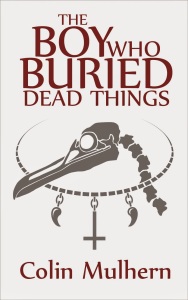Publication Date: May 2, 2015
Source: Can be bought from Amazon’s US, UK, and Canadian sites, among others.
Format: E-book
Pages: 179 pages
Summary: When the body of a teenager is discovered in a shallow grave in a secluded part of South Shields’ shoreline, suspicions are focussed on David Marsh – a boy who can’t talk, can barely walk, and has a particularly strange and disturbing hobby.
Short Version: I love this book. Finally, teenagers in fiction who act like… actual teenagers.
Longer Version: You have to admit that that’s one hell of a catchy title.
And an eye-catchingly good cover, too, come to think of it. It all points to a writer who knows what he’s doing, and in The Boy Who Buried Dead Things, Colin Mulhern doesn’t disappoint.
At its plot level, this is as tense and jam-packed with twists and turns as the best of whodunits on TV (I am not a snob when it comes to my whodunits, well-written is well-written, and this is.) By the end, no ties are loose, no details are thrown in for no apparent reason. Clues are set up immaculately, and the shifting timeline adds an extra dimension to the story (after a killer first line, the story is told in flashback by Tegs/Tom, who is sitting in a police interview room.) Mulhern throws us immediately into the consequences of the discovery of the body, without pausing for how-this-happened storyline first, a flaw I see in a lot of novels.
But it’s the characters that lift this one from great to extraordinary. Mulhern seems entirely uninterested in dividing the cast into “goodies” and “baddies”, and instead hits on this universal truth – in their own head, nobody is the baddy. And even bad people have their own internal code of conduct and behaviour they think is wrong and wouldn’t stoop to. The world doesn’t need any more take-over-the-world villains with cats on lap and shark tanks at ready.
Tom (“Tegs”, for a hilariously unfortunate reason I won’t spoil) is an incredibly likeable hero, neither pressing himself intrusively into the narrative nor lacking in personality. His reactions are realistic to a painful degree – he knows that Davy’s autism is not his fault and struggles with reactions to him based on fear and ignorance. In one touching moment, this fifteen-year-old boy bursts into tears and gets a hug from his mother (and lord, am I sick of seeing orphans and otherwise abused kids in YA fiction.)
Chris (“Weasel”, a nickname that unfortunately had me picturing him as Rupert Grint) is strongly implied to be an “otherwise abused kid”. He’s from a rough end of town and it’s implied his folks don’t much care what he does – until he does something deserving of a beating. Weasel is the sort of person I can’t imagine living past his twenties. He’s a ball of runty bravado, fighting people over and over again (and uniformly being seriously injured in the process.) Another character refers to him as an “arrogant little shit” and she’s right – Weasel has no problems calling a disabled boy a “retard” and trying to beat him up for little more than just existing. This character is as complex and more than a little disturbing. Not likeable, but all the more realistic for it.
But it’s the character of Kelly who holds my heart. The straight-talking fixer of the group, Kelly is the sort of heroine more teenage girls need to read and emulate. She’s poised and mature, often not engaging with the ridiculous behaviour of the boys around her. She picks her battles and rarely, say, gives in to the impulse to hit Weasel over the head with a baseball bat, but she has a strong moral compass and isn’t afraid to stand up in what she believes in. Her objection over the word “retard” and “retarded” being thrown around is expertly done – she sounds sincere without getting on her high-horse. And when a boy who slapped her wants to know if they’re still dating, her answer made me cry with joy.
Aside from this trio, even peripheral characters are done well. Davy is a sympathetic portrayal of autism, but not one that strays into inspiration porn – the boy has problems. His mother is a particularly vivid character, a woman both old and wise beyond her years, and I could have read about her all day. Even our primary antagonists (Paul and Greg, otherwise known as “Bloat”) come across as real people. The only one of the bunch I had no use for at all was Helen, Tegs’s Manic Pixie Dream Girl. I can’t help but think there’s a reason for that.
The ocean and its surrounds bleed into every word of this extraordinary novel, so much that I could almost smell the brine while I was reading. I’m not familiar with the part of England that it’s set in, but reading reviews from those who are, it seems Mulhern has lovingly and accurately portrayed his home-town in exquisite detail. For that, too, I salute him.
I got this book for free, but it’s still inexpensive, and a damn good read. Highly recommended.


Tag! You’re it! I’ve Nominated you for the Liebster Award 🙂
LikeLike
Reblogged this on Barrow Blogs.
LikeLike
Brilliant, thank you!
LikeLike
Pingback: What Turns Me On and Off Your Book, Part 1: The Title | The Reader In the Tower